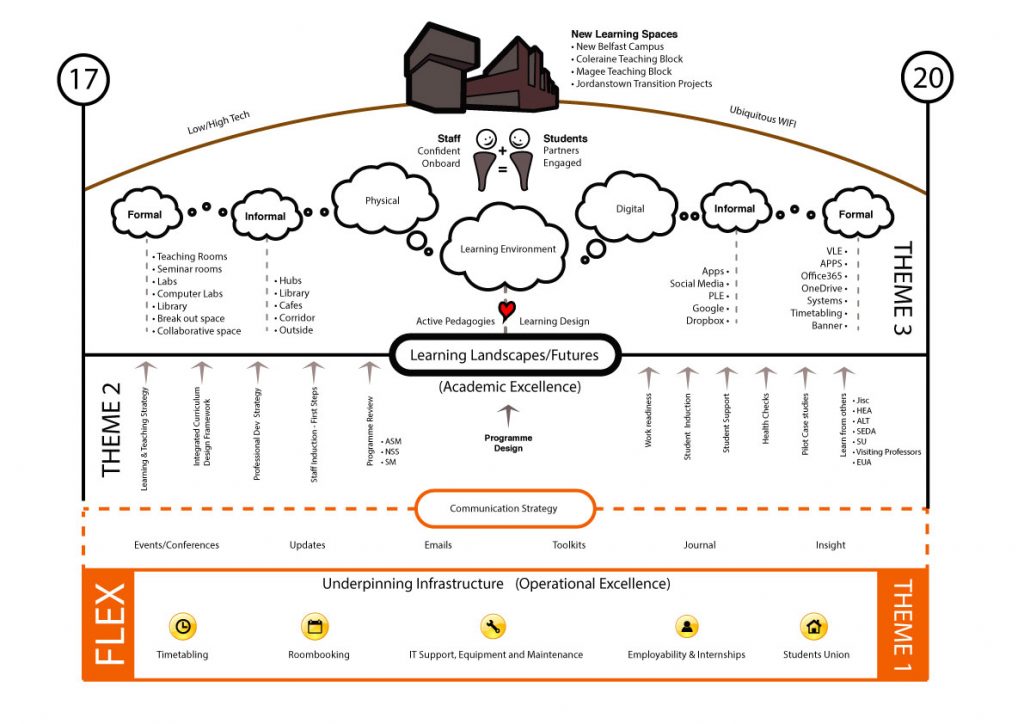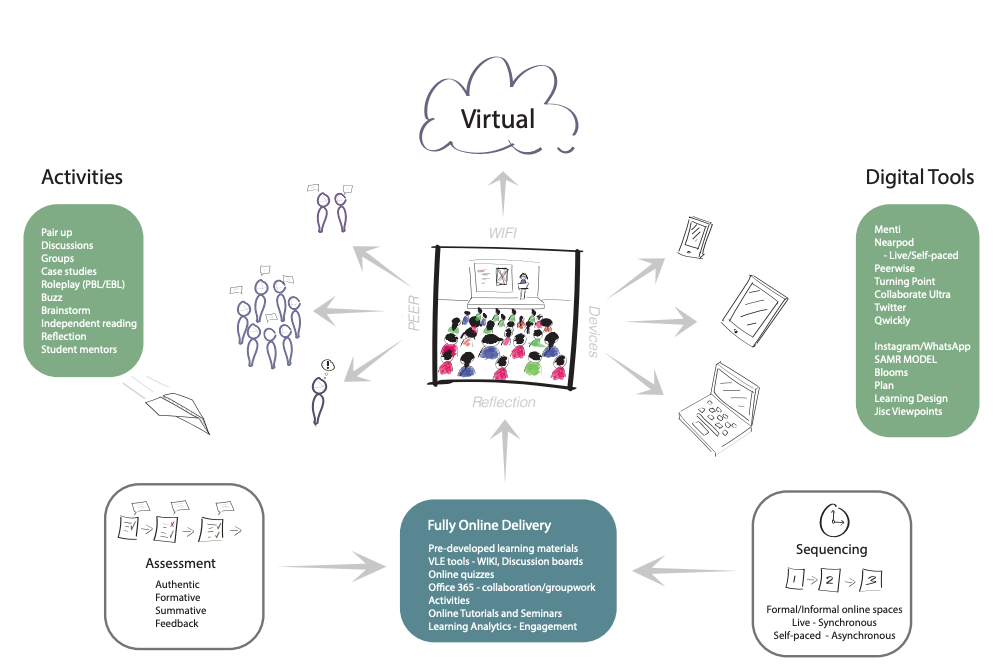Although not a new concept, it is widely acknowledged that active learning is an effective way to enhance the learning experience of our students, giving them opportunities to engage with their learning in an authentic and social way [1] that not only enhances their subject specific knowledge and provides opportunities for meaningful learning [2], but also the softer skills that employers are looking for [3]. Like many HE institutions Ulster University has invested heavily in its physical and digital learning environments over the last few years in order to continue to enhance student learning experiences and encourage active and collaborative learning across our 4 campuses. We have new teaching blocks in two of our campuses and are currently coming to the end of constructing our new campus in Belfast housing 15,000 staff and students. However, it isn’t just a matter of providing these learning environments and hoping for the best. To borrow a quote from the movie Field of Dreams, it isn’t as simple as “Build it and they will come”, careful planning and consideration is needed to move away from the timetabled, 3-hour didactic lecture so that we aren’t trying to do the same things in a new space and missing out on the opportunities provided through active and collaborative learning, especially as we enter the recovery period of the pandemic.
Where did it all start?
Back in 2017 a strategic approach to encourage active and collaborative learning was needed to address the tacet assumptions of higher education learning and teaching, for both students and staff. This took the shape of the learning environment plan. When developing this plan [4] it became very clear that both staff and students needed support and guidance to facilitate its adoption so that they were confident and onboard with the plans and that they were working as collaborative partners. At Ulster University we have a lot of good academic practice around active learning happening across the institution, but a platform for sharing this practice was missing as was the acknowledgement and reward. At the end of the day the focus of any change in pedagogic practice, whether physical or digital has to be about people, without people a classroom is just an empty room. This has been a holistic approach looking at all facets that impact on enhancing student and staff experiences by placing people at the centre as change agents. Learning technology integration shouldn’t be seen as an ‘add-on’ or an afterthought, but as integral as access to electricity for lighting our learning environments. This plan looks at the synergies between underpinning infrastructure, professional development, the learning environment (physical/virtual and formal/informal), digital technologies and how staff and students interact with them all through active learning pedagogies and provides resources to help embrace into their practice. As a result, a number of strategically aligned initiatives were created: Active Learning Champions, Learning Partners; Apps for Active Learning, Learning Landscape toolkits and resources, The Learning Lab and New Learning Spaces (20 rooms) refurbishment pilots [4].

Then Covid-19 arrived
Did Covid impact on this plan? The short answer is yes, but in a good way. The eighteen Active Learning Champions, who had been in place for a year and a half helped facilitate the online pivot within their schools, supporting staff with the switch in mode of delivery. The Student Learning Partners who had been working since January 2020 in partnership with academic and professional support staff to adopt appropriate learning technology switched to online delivery from their homes. Helping staff record lectures on Panopto and orientating them with Mentimeter and Nearpod to enhance delivery with over 100 hours collaborative partnership. Apps for Active Learning had previously secured funding and sustainability of Nearpod and Mentimeter, which were heavily used during the first lockdown and this academic year with usage jumping from 30,000 to 60,000 student engagements. The learning landscapes tools and resources were tweaked for fully online delivery being used as the general guidance across the institution on getting the basics right [5]. Unfortunately, as the campuses were closed the learning lab and the 20 refurbished rooms weren’t used as expected, but the learning sequencing pilot which ran from Jan to March 2020, gave us invaluable insights into how staff and students view active learning and the flipped classroom approach giving us a solid evidence-base for adopting the blended approach once we return to face-to-face teaching.

What does that mean for the future?
Everyone involved in Higher Education teaching has had to re-evaluate their practice to ensure online engagement during lockdown through active learning and collaboration. Staff at Ulster University have gone above and beyond for their students and the learning environment plan and its projects gave us a good starting point for the online pivot. One thing has been clear, active learning has been an integral part of lockdown, although not quite how it was envisaged pre-Covid.
As we tentatively start the journey towards the recovery stage of the pandemic, we have a unique opportunity to reflect on what worked well and not so well since the online pivot in March 2020. At Ulster our Active Learning Champions are as important as ever and the Student Learning Partners are being scaled up from September 2021 to provide 4,000 hours of staff/student collaborative partnership to facilitate active learning. Supporting people and learning from the lessons over the last 18 months will help us shape the future of learning and teaching for decades to come and ensure an active and collaborative focus going forward whether that is face-to-face, blended or fully online. Whatever the future may hold, we are all better prepared.
Editor’s note: Richard will give a presentation on 6 May at the Media & Learning Online Conference. Find out more here.

Author
Richard Beggs
Lecturer, Ulster University, Learning Landscapes Lead, Chair of ALT Active Learning SIG













